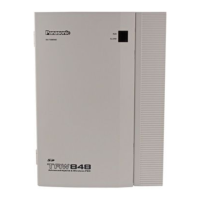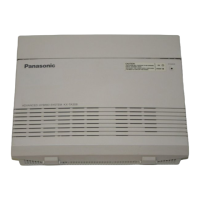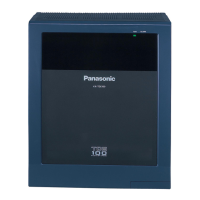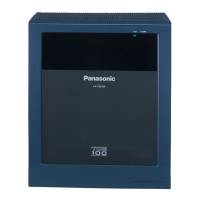1.20 Portable Station (PS) Features
Feature Guide 147
range of another CS, the PS will "hand over" its communications to the new CS. Handover is possible
when:
a) The PS is on an intercom call or on a call with an outside party. (The call will not be disconnected
during the handover.)
b) A call is ringing at the PS. (The call will continue to ring after the handover.)
c) The PS is in idle status (i.e., waiting to receive calls).
[Example of Handover]
Handover is not possible when the PS is:
a) Not within range of another CS.
b) Within range of another CS but that CS is busy.
c) Screening a call via Live Call Screening (LCS) or recording a call via Two-way Record ( 1.19.2
Voice Mail DPT (Digital) Integration)
d) Paging other extensions. ( 1.14.1 Paging)
e) On a doorphone call.
f) Dialing digits to make a CO line call.
Conditions
• If every CS that a PS is in range of is busy when that PS is called, the call will not be connected and
the caller will hear a busy tone.
Installation Manual References
2.7 Connection of 2.4 GHz Portable Stations
1.20.2 PS Ring Group
Description
A PS ring group is a way for several portable stations (PSs) to be notified of an incoming call simultaneously,
while using only one channel of a cell station (CS).
Normally when a PS receives a call, one channel of a CS is used to ring the PS (→ 1.20.1 Portable Station
(PS) Connection). If several PSs are members of an incoming call distribution (ICD) group, the available
channels of a CS will become busy just by ringing each PS. Assigning a group of PSs to a PS ring group
alleviates this strain on the CS because only one channel is needed to ring a PS ring group's members.
Call is not disconnected
Handover
CS-2CS-1 CS-2CS-1
Moving

